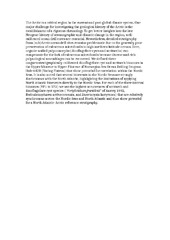| dc.contributor.author | De Schepper, Stijn | |
| dc.contributor.author | Beck, Kristina Marie | |
| dc.contributor.author | Mangerud, Gunn | |
| dc.date.accessioned | 2017-11-07T09:00:02Z | |
| dc.date.available | 2017-11-07T09:00:02Z | |
| dc.date.issued | 2017-01 | |
| dc.Published | De Schepper S, Beck KM, Mangerud G. Late Neogene dinoflagellate cyst and acritarch biostratigraphy for Ocean Drilling Program Hole 642B, Norwegian Sea. Review of Palaeobotany and Palynology. 2017;236:12-32 | eng |
| dc.identifier.issn | 1879-0615 | en_US |
| dc.identifier.issn | 0034-6667 | en_US |
| dc.identifier.uri | https://hdl.handle.net/1956/16860 | |
| dc.description.abstract | The Arctic is a critical region in the current and past global climate system. One major challenge for investigating the geological history of the Arctic is the establishment of a rigorous chronology. To get better insights into the late Neogene history of oceanographic and climatic change in the region, well-calibrated ocean drill cores are essential. Nevertheless, detailed stratigraphy from (sub)Arctic ocean drill sites remains problematic due to the generally poor preservation of calcareous microfossils in high northern-latitude oceans. Here, organic-walled palynomorphs (dinoflagellate cysts and acritarchs) can compensate for the lack of calcareous microfossils because diverse and rich palynological assemblages can be recovered. We defined three magnetostratigraphically-calibrated dinoflagellate cyst and acritarch biozones in the Upper Miocene to Upper Pliocene of Norwegian Sea Ocean Drilling Program Hole 642B (Vøring Plateau) that show potential for correlation within the Nordic Seas. It is also noted that several bioevents in the Nordic Seas are strongly diachronous with the North Atlantic, highlighting the limitations of applying North Atlantic bioevents directly to the Nordic Seas. For each of the three interval biozones (VP1 to VP3) we use the highest occurrences of acritarch and dinoflagellate cyst species (“Veriplicidium franklinii” of Anstey 1992, Reticulatosphaera actinocoronata, and Invertocysta lacrymosa) that are relatively synchronous across the Nordic Seas and North Atlantic and thus show potential for a North Atlantic–Arctic reference stratigraphy. | en_US |
| dc.language.iso | eng | eng |
| dc.publisher | Elsevier | en_US |
| dc.rights | Attribution CC BY-NC-ND | eng |
| dc.rights.uri | http://creativecommons.org/licenses/by-nc-nd/4.0/ | eng |
| dc.subject | Miocene | eng |
| dc.subject | Pliocene | eng |
| dc.subject | Palynology | eng |
| dc.subject | Biozones | eng |
| dc.subject | Nordic seas | eng |
| dc.subject | North Atlantic | eng |
| dc.title | Late Neogene dinoflagellate cyst and acritarch biostratigraphy for Ocean Drilling Program Hole 642B, Norwegian Sea | en_US |
| dc.type | Peer reviewed | |
| dc.type | Journal article | |
| dc.date.updated | 2017-09-29T13:08:43Z | |
| dc.description.version | acceptedVersion | en_US |
| dc.rights.holder | Copyright 2016 Elsevier B.V | en_US |
| dc.identifier.doi | https://doi.org/10.1016/j.revpalbo.2016.08.005 | |
| dc.identifier.cristin | 1383531 | |
| dc.source.journal | Review of Palaeobotany and Palynology | |
| dc.relation.project | Norges forskningsråd: 221712 | |
| dc.relation.project | Norges forskningsråd: 229819 | |

